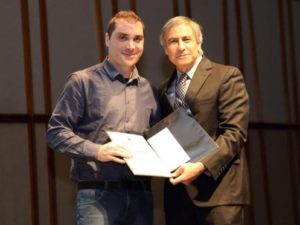Université de Tel Aviv : Tracense (Israël) met au point des puces nanos pour flairer les explosifs

[:fr]Une nouvelle puce électronique dotée de capteurs chimiques de taille nanométrique est sur le point de révolutionner les procédures de sécurité dans les aéroports et autres lieux publics partout dans le monde. Ce capteur nanotechnologique qui repose sur un procédé révolutionnaire, est mis au point à l’Université de Tel-Aviv par le Pr Fernando Patolsky.
Les forces de sécurité dans le monde utilisent un matériel sophistiqué, un personnel qualifié, et des chiens de détection pour protéger les aéroports et autres lieux publics contre les attaques terroristes. Mais ces matériels sont souvent coûteux et encombrants. Cette nouvelle puce électronique, qui s’inspire de notre système olfactif, va leur permettre de faire leur travail de façon beaucoup simple et fiable.
Ce capteur nanotechnologique, mis au point par le Pr Fernando Patolsky de l’école de chimie de l’Université de Tel Aviv et du Centre de nanosciences et de nanotechnologies, et développé par la société Tracense basée à Herzliya, capte l’odeur des explosifs molécules mieux que le nez d’un chien de détection. Ce dispositif mobile, peu coûteux et de haute précision, détecte les explosifs dans l’air à des concentrations ultra faibles, à peine quelques molécules pour 1 000 milliards. Ce détecteur peut donc identifier à distance des quantités infimes de molécules que les autres détecteurs ne peuvent pas reconnaitre.
Tracense a déjà investi des millions de dollars dans le prototype, actuellement en cours de test. Les centres commerciaux, les gares et autres lieux publics pourront s’en équiper.
https://www.youtube.com/watch?v=IWGsZo7svvo
Ces travaux ont été récemment publiés dans la revue Nature Communications.
Complete story on: http://www.eurekalert.org/pub_releases/2014-07/afot-nc072314.php[:en]Security forces worldwide rely on sophisticated equipment, trained personnel, and detection dogs to safeguard airports and other public areas against terrorist attacks. A revolutionary new electronic chip with nano-sized chemical sensors is about to make their job much easier.
The groundbreaking nanotechnology-inspired sensor, devised by Prof. Fernando Patolsky of Tel Aviv University‘s School of Chemistry and Center for Nanoscience and Nanotechnology, and developed by the Herzliya company Tracense, picks up the scent of explosives molecules better than a detection dog’s nose.
Existing explosives sensors are expensive, bulky and require expert interpretation of the findings. In contrast, the new sensor is mobile, inexpensive, and identifies in real time — and with great accuracy — explosives in the air at concentrations as low as a few molecules per 1,000 trillion.
A nano-nose to compete with a dog’s
« Using a single tiny chip that consists of hundreds of supersensitive sensors, we can detect ultra low traces of extremely volatile explosives in air samples, and clearly fingerprint and differentiate them from other non-hazardous materials, » said Prof. Patolsky, a top researcher in the field of nanotechnology. « In real time, it detects small molecular species in air down to concentrations of parts-per-quadrillion, which is four to five orders of magnitude more sensitive than any existing technological method, and two to three orders of magnitude more sensitive than a dog’s nose.
« This chip can also detect improvised explosives, such as TATP (triacetone triperoxide), used in suicide bombing attacks in Israel and abroad, » Prof. Patolsky added.
The clusters of nano-sized transistors used in the prototype are extremely sensitive to chemicals, which cause changes in the electrical conductance of the sensors upon surface contact. When just a single molecule of an explosive comes into contact with the sensors, it binds with them, triggering a rapid and accurate mathematical analysis of the material.
« Animals are influenced by mood, weather, state of health and working hours, the oversaturation of olfactory system, and much more, » said Prof. Patolsky. « They also cannot tell us what they smell. Automatic sensing systems are superior candidates to dogs, working at least as well or better than nature. This is not an easy task, but was achieved through the development of novel technologies such as our sensor. »
https://www.youtube.com/watch?v=IWGsZo7svvo
A technology for a safer world
The trace detector, still in prototype, identifies several different types of explosives several meters from the source in real time. It has been tested on the explosives TNT, RDX, and HMX, used in commercial blasting and military applications, as well as peroxide-based explosives like TATP and HMTD. The latter are commonly used in homemade bombs and are very difficult to detect using existing technology.
« Our breakthrough has the potential to change the way hazardous materials are detected, and of course should provide populations with more security, » said Prof. Patolsky. « The faster, more sensitive detection of tiny amounts of explosives in the air will provide for a better and safer world. »
Tracense has invested over $10M in research and development of the device since 2007, and expects to go to market next year. Prof. Patolsky and his team of researchers are currently performing multiple and extensive field tests of prototype devices of the sensor.
Research on the sensor was recently published in the journal Nature Communications.[:]







